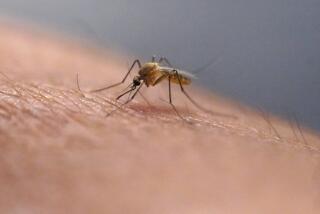A Buzz and Beyond
- Share via
Sentinel chickens and mosquitofish may sound like improbable allies in the fight against a deadly disease, but when the enemy is carried by insects, it’s like sending in the Marines.
Orange County Vector Control officials say the threat of potentially fatal encephalitis has risen this year because of the vast number of mosquitoes expected to swarm this summer. And the mosquito outbreak is yet another calling card of El Nino.
The wet weather created more breeding grounds for the bloodsuckers, which lay their eggs in stagnant pools. And unless the public helps by emptying standing water caught in old tires, bird baths, idle kiddie pools or neglected fish ponds, the bugs won’t be just an annoyance.
In 1984, Southern California saw an unprecedented outbreak of the mosquito-borne St. Louis encephalitis virus--26 cases and six deaths, including one in Orange County. Like this year, 1984 followed an El Nino season.
“Everyone is expecting a greater number of mosquitoes because of the wetter conditions, but that doesn’t necessarily mean an increase in the disease,” said Dr. Hildy Meyers, the County Health Care Agency’s medical director of communicable disease and epidemiology. “We don’t really have a good way of predicting whether we will have an outbreak.”
The best method available to determine whether there may be an outbreak is to monitor sentinel chickens kept in coops at the San Joaquin Wildlife Sanctuary in Irvine. Scientists there periodically test the birds’ blood for encephalitis, which the mosquitoes transmit from smaller birds (which carry the disease naturally) to humans and other animals, such as chickens.
Meyers said the tests run from May through October, but one of the chickens tested positive unusually early this year, alarming health officials. No other cases have been detected, Meyers said.
Vector Control officials also trap wild finches and sparrows--the natural carriers of encephalitis--and test them. Three birds tested positive in May at Irvine, Fullerton and Seal Beach, said agency education coordinator James G. Francisco.
While the birds serve as the early-warning system against the virus, the mosquitofish carry out the preemptive first strike.
The fish, Gambusia affinis, are a voracious form of guppy that “eat mosquito larvae as fast as they hatch from the eggs,” and thus curb the bug population before it matures, according to Vector Control literature.
The agency gives away mosquitofish so people can put them in unused pools, decorative ponds and animal troughs. The agency also releases thousands of them every year in reservoirs, artificial lakes, drainage channels and waste-water lagoons.
Meyers said the precautions are vital to reduce outbreaks of encephalitis, which most threatens the very young and very old. St. Louis encephalitis has an 8% fatality rate, but that rises to 20% for victims 60 and older, Meyers said. And children are most vulnerable to Western equine encephalitis, which also is carried by mosquitoes.
Both start with flu-like symptoms that include fever, chills, headaches, nausea, confusion and drowsiness, Meyers said.
To guard against bites, Francisco said people should avoid going out at dusk, wear insect repellent, long sleeves and pants. He also suggests people repair screens so the insects can’t get indoors and remove any outdoor standing water.
Francisco also said residents should report any standing water so Vector Control workers can spray the puddles or tip over abandoned tires.
And even a single mosquito bite shouldn’t be written off as the price of enjoying a summer evening. Report it to Vector Control, Francisco said.
“Where there’s one mosquito, there’s more,” he said.
(BEGIN TEXT OF INFOBOX / INFOGRAPHIC)
Biting Back
In its fight against the summertime surge in mosquitoes, Orange County Vector Control tries to eliminate the standing bodies of water where they breed. But in larger areas that can’t be drained, the agency employs larvae-eating fish to cut down on the buzzing menace.
Mosquitofish
Here’s one little fish that makes a big difference in the mosquito population:
* Size: A quarter of an inch at birth; reaches full size of 3 inches in six to eight weeks
* Diet: Mosquito larvae
* Breeding: Produces 50 to 100 young every six weeks during summer
* Care: Must be protected from insecticides, chlorine and other chemicals used to clean ponds or pools
* Availability: Free; call Orange County Vector Control District at (714) 971-2421
Mosquitoes Close Up
The insect’s long narrow “beak” is used to siphon plant juices and blood from mammals. Mosquitoes breed year-round, with eggs growing into adults in about 10 days. A female can bear about 3,000 young in a lifetime.
Males: Feed on plant juices and do not bite humans.
Females: Obtain protein needed to lay eggs from the blood of birds and mammals, including humans.
LIFE CYCLE
Mosquitoes pass through four stages, each marked by physical transformation:
1. Egg raft: Groups of 100-300 eggs laid at one time on water’s surface; eggs usually hatch in two to three days.
2. Larva: Lives underwater; molts four times in four to 10 days, then changes into pupa
3. Pupa: Shaped like a comma, within two to four days it swims to surface where adult emerges from pupal skin.
4. Adult: Males live seven to 10 days; females can live longer in protected environments
One mosquitofish (Gambusia affinis) can devour over 100 mosquito larvae per day
MOSQUITO PREVENTION TIPS
* Remove standing water from yard.
* Cover or turn over empty containers.
* Clean swimming pools, spas, ornamental ponds daily.
* Add mosquito-eating fish to ponds, channels.
* Spray breeding areas with insecticide.
* Fill in unused ornamental ponds with sand or dirt.
To Report Infestations: Standing water or mosquito swarms should be reported to Orange County Vector Control at (714) 971-2421
Source: Times reports, Orange County Vector Control
More to Read
Sign up for Essential California
The most important California stories and recommendations in your inbox every morning.
You may occasionally receive promotional content from the Los Angeles Times.













